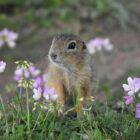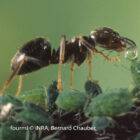How do leaf cutter ants farm fungi?

Leaf cutter ants, fascinating creatures native to the Americas, engage in a complex and remarkable form of symbiosis by farming fungi. Their sophisticated agricultural system involves a mutualistic relationship with a specific type of fungus.
Leaf Cutter Ants Fungus Farming
Leaf cutter ants, which belong to the genera Atta and Acromyrmex, exhibit an extraordinary level of sophistication in their agricultural practices. At the core of their unique farming behavior lies their exceptional ability to cultivate and maintain fungal gardens within their colonies.
These fungus gardens are not merely incidental to the ants’ survival but are the primary source of their sustenance. The process of fungus cultivation within leaf cutter ant colonies involves a series of intricate and coordinated steps, showcasing the complexity of their farming practices.
Leaf cutter ants are meticulous foragers, collecting leaves from various plant species and carrying them back to their underground nests. Instead of directly consuming the leaves, they use them as a substrate for cultivating a specific type of fungus, primarily Leucoagaricus gongylophorus. The ants cut the fresh leaves into smaller, more manageable fragments and transport them back to the nest, where they serve as the substrate for the fungal gardens.
Leaf Cutter Fungi Gardens
Once inside the nest, the leaf cutter ants further process the leaves. They chew the leaf fragments into a paste-like consistency, increasing the surface area and providing the ideal substrate for the growth of the fungus. This preparation is essential, as the fungus relies on this processed leaf material for its nourishment and growth.
The ants exhibit remarkable agricultural skills by creating and maintaining specialized chambers within their colonies dedicated to fungus cultivation. These areas provide a controlled environment with optimal temperature, humidity, and ventilation to promote fungal growth. The ants carefully tend to their gardens, ensuring that the conditions remain conducive for the fungus to thrive.
Leaf Processing
Leaf cutter ants are meticulous in their approach to leaf processing, as this is a critical step in their intricate farming process. These ants, known for their industrious nature, engage in a systematic and labor-intensive leaf preparation method to cultivate their fungal crops within the colony’s chambers.
Once within the colony, the ants’ industrious workforce takes charge of the leaf processing. They don’t simply consume the leaves directly but engage in a multi-step procedure to create an optimal environment for their fungal cultivation.
The leaves, despite being rich in cellulose and other challenging compounds, are unsuitable for direct consumption by the ants. To make them suitable for their fungal gardens, the ants employ a series of steps. The first involves chewing the leaves using their powerful mandibles. This chewing action macerates the leaves, breaking them down into smaller pieces, which helps rupture the tough cell walls and facilitates microbial activity.
As the leaves are reduced to a pulpy consistency, the ants add their oral secretions to the leaf mass. These oral secretions are known to contain a rich array of enzymes and other substances that not only assist in further breaking down the leaves but also introduce substances conducive to the growth of the Leucoagaricus gongylophorus.
The ants’ saliva contains a symbiotic community of microorganisms that contribute to the preparation process. These microbes assist in the breakdown of complex plant materials, aiding in the initial stages of fermentation necessary for the growth of the specialized fungus. This mixture of the ants’ saliva, enzymatic breakdown, and introduction of specific microorganisms all foster an environment suitable for the growth of the fungal crop.

Symbiotic Relationship between Leaf Cutter Ants and Fungi
The symbiotic relationship between leaf cutter ants and the fungus they cultivate within their colonies represents an intricate and mutually beneficial partnership. Over millions of years of evolution, these two distinct organisms have developed a dependence on one another, each playing a crucial role in the survival and sustenance of the other.
For the ants, the fungus serves as their primary and essential food source. Leaf cutter ants are herbivores, yet they cannot directly digest the cellulose found in fresh leaves. However, the cultivated fungus breaks down this cellulose into more digestible compounds, effectively predigesting the leaf material for the ants. This symbiosis grants the ants access to vital nutrients that they would otherwise be unable to obtain, ensuring the colony’s survival and growth.
Conversely, the fungus thrives on the leaves provided by the ants and is entirely reliant on the colony for its cultivation. The ants maintain a conducive environment for the fungus to grow by processing the leaves and creating carefully regulated conditions within their nests, such as controlling humidity and temperature. In turn, the fungus provides essential sustenance to the ants, illustrating a perfect example of interdependence.
The mutual benefits stemming from this cooperative partnership emphasize the level of coevolution between these organisms. This relationship is characterized by a delicate balance, where each party fulfills a role vital to the other’s survival.
Leaf cutter ants protect, nurture, and cultivate the fungus, ensuring a continuous and reliable source of food for the colony, while the fungus offers the ants the means to access and digest vital nutrients from their environment.

Challenges of Fungi Farming
Maintaining a healthy fungus garden poses significant challenges for leaf cutter ants. The cultivation of their fungal crops demands precise environmental conditions and vigilant care to ensure the optimal growth and sustenance of the Leucoagaricus gongylophorus. Several challenges can potentially compromise the fungus gardens within the ant colonies.
One of the primary challenges faced by the leaf cutter ants is the susceptibility of their fungal crops to contamination. The gardens can be infiltrated by parasitic fungi or molds that threaten the health and growth of the cultivated fungus.
To counter these potential threats, the ants exhibit sophisticated agricultural practices. They display an innate understanding of maintaining a balanced ecosystem within their colonies. If any unwanted organisms invade the fungus garden, the ants engage in behaviors such as grooming and applying substances containing antimicrobial properties to protect their cultivated crops.
Moreover, as with any form of agriculture, fluctuations in environmental conditions and nutrient availability can affect the health of the fungus gardens. Leaf cutter ants meticulously regulate the microclimate of their nests, controlling factors such as temperature and humidity to create an optimal environment for their crops.
Tending the garden
To address these challenges, leaf cutter ants have evolved behaviors that demonstrate a remarkable level of agricultural intelligence. They employ strategies to protect their fungal crops, such as constant grooming to prevent the spread of potentially harmful microorganisms and the use of antibiotics derived from Actinobacteria carried on their bodies to suppress harmful fungi.
The waste produced by the fungus garden, a byproduct of the ants’ fungal agriculture, is collected and used to fertilize new leaf fragments. This waste recycling method plays a crucial role in sustaining the fungus gardens and in turn, the ant colonies.
The leaf cutter ants’ sophisticated fungal agriculture is a remarkable example of cooperative behavior and intricate ecological interactions. While the intricacies of this farming system are still being researched, the mutual relationship between the ants and their cultivated fungus highlights the incredible complexities and strategies that have evolved in nature over time.










